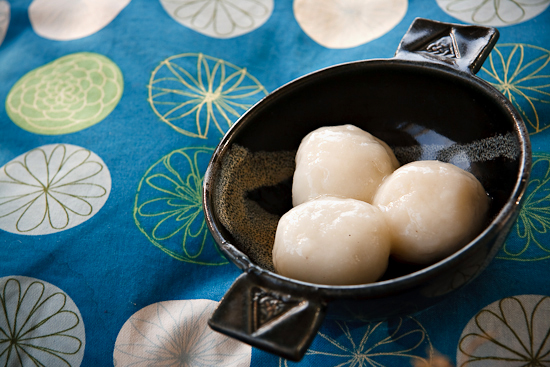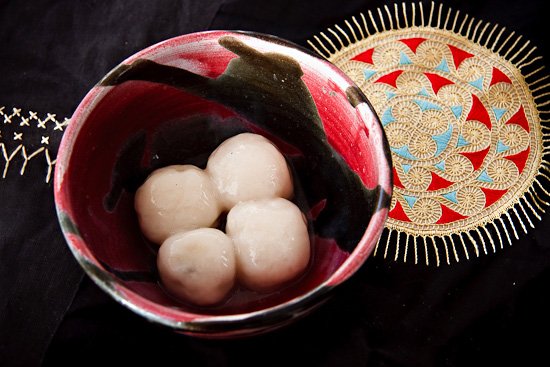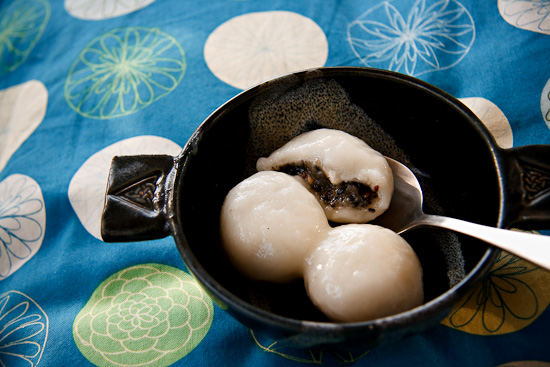Happy year of the rabbit, everyone! (In Vietnam, it’s the year of the cat, incidentally.)
If you’re looking for special Chinese New Year (or Spring Festival) treats, you can’t really do better than the niangao (年糕) from Mr Bai of Bai Ji Niangao. His glutinous rice cakes are perfectly textured, generously layered with red bean paste, and well worth lining up for. (It’s also important to eat niangao for Spring Festival to ensure that the new year is ‘higher’ or more gao than the previous one.)
While you’re there, you may also notice that Mr. Bai has something different: yuanxiao (元宵).
These stuffed balls of glutinous rice flour are sold only from the few weeks before Chinese New Year to the Lantern Festival (on the 15th day of the 1st lunar month, February 17th in 2011). This year, Mr. Bai started selling yuanxiao as early as January 15th, so they’re around for about a month in total. They’re stuffed with a wide range of delicious fillings, and cooked by gently simmering in clear water (Chinese style) or with the addition of ginger and roasted peanuts (northern Vietnamese style).
Yuanxiao, however, are not to be confused with tangyuan (汤圆), though to the untutored eye or mouth, they are nearly identical in form and function. They both fulfill any craving for the utterly unique, sticky, chewy texture of glutinous rice, and are especially satisfying on a cold winter’s morning. Their perfect white spheres represent the word tuanyuan (团圆), or the idea of reuniting (团) in the family circle (圆) for the holidays.
Tangyuan are a treat of southern China, and eaten (I think) year-round, while yuanxiao are northern, from the Beijing-Tianjin region, and only made from Spring Festival until the eponymous Lantern Festival (元宵节, Yuanxiao Jie). Yuanxiao are also larger, with a “chewier”, bouncier skin, while tangyuan are softer and more yielding. If you like the sticky-chewy texture of mochi, yuanxiao are more for you.
The textural difference is no doubt, due to the construction: Yuanxiao are made like a snowball, rolled in glutinous rice flour. The filling is first formed into little spheres, which are then shaken together in a grass basket full of glutinous rice flour. As they roll around, they pick up flour. Every once in a while, the growing yuanxiao are dipped in water to moisten them and help them pick up more rice flour, until they reach ping pong ball size. In contrast, tangyuan (汤圆) are made dumpling-style: first the glutinous rice flour is mixed into a dough, which is then formed by hand into flat rounds and wrapped around the filling.
Yuanxiao are always made and sold fresh at traditional pastry and sweets/snacks shops. If you don’t eat them on the day of purchase, freeze them as soon as possible and eat within 2 to 3 days. If it comes from the frozen goods aisle of a supermarket, it’s definitely tangyuan.
The venerable Daoxiangcun (稻香村), the aforementioned Bai Ji, and Huguosi Xiaochi Dian (护国寺小吃店) all sell yuanxiao around this time of year. I’ve tried them all before; this year I stuck to Bai Ji and Huguosi, my two favorites. Mr. Bai is a decided wizard of glutinous rice, and Huguosi is a well-respected shop for traditional Beijing snacks, pastries, and treats – every morning for breakfast it draws a busy crowd of hutong residents, elderly Beijingers, workers, and traffic cops stationed nearby.
Unfortunately, the Huguosi yuanxiao were not as wonderful as I remembered from past years. The fillings, in black sesame and hawberry (shanzha 山楂) flavors, were too sugary – the granules of sugar dominated the hawberry filling, in fact. The glutinous rice skin, however, was delightfully chewy and bouncy, slightly thicker than the skin of Baiji Niangao, though I don’t mind that.
The yuanxiao from Bai Ji are some of the best I had, though certain fillings are superior to others. The sticky rice skin looks floury and altogether precarious when raw, but once cooked, it sets perfectly into a glossily smooth yet sticky texture. The black sesame (黑芝麻 heizhima) filling was my favorite, but I also like the osmanthus flower (桂花 guihua), with an indescribably sweet but not cloying fragrance. The “five nut” filling (五仁 wuren) could have used more nuts, and while the hawberry variety had more berry flavor than that of Huguosi, it was still not enough hawberry for me.
Bai Ji Niangao 白记年糕: Address and mapHuguosi Xiaochidian 护国寺小吃店
93 Huguosi Dajie [map]
Xicheng District
Tel: (10) 6618 1705
西城区护国寺街93号
214 Dongsi Beidajie, Dongcheng District [map]
(just south of the southeast exit of Zhangzizhong Lu subway stop)
Tel: (10) 6402 1798<
东城区东四北大街214号(近平安大道)


































one of my favourites! Happy new year shelley! gongxifacai!